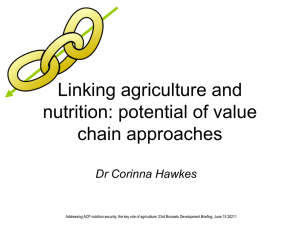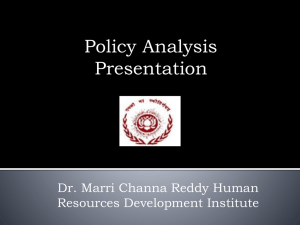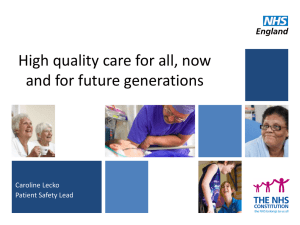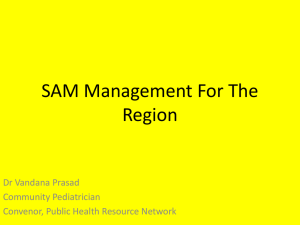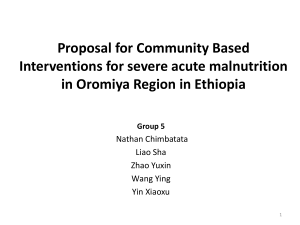Group 4
advertisement
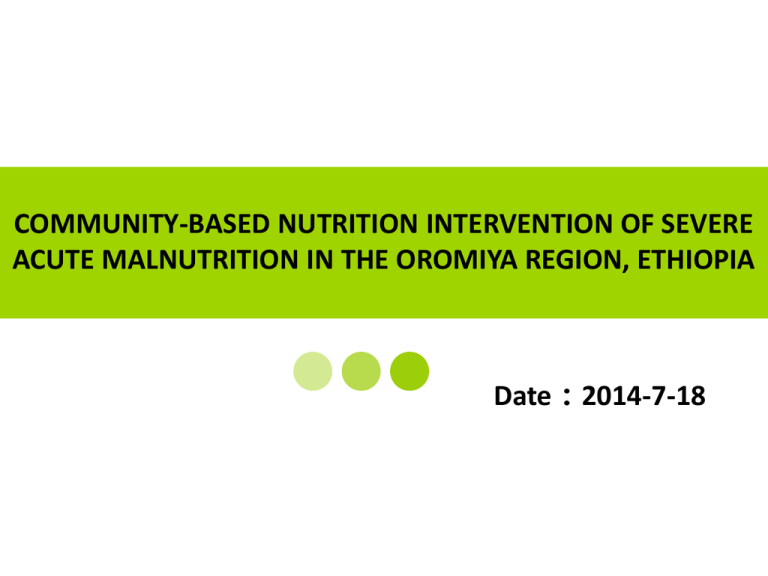
COMMUNITY-BASED NUTRITION INTERVENTION OF SEVERE ACUTE MALNUTRITION IN THE OROMIYA REGION, ETHIOPIA Date:2014-7-18 Group 4 Family GROUP 4 LI LU(李璐) CECILIA ELIASON CHENG YUE(程越) LI QIUJU(黎秋菊) LI QIXIANQI(李宪琪) 2 Outline 3 Abstract Ethiopia has one of the highest child malnutrition rates in the world. Aim: to reduce the burden of Severe Acute Malnutrition among under fives in Oromiya Region of Ethiopia. Method: a quantitative and qualitative design to assess the U5 with SAM using a community based nutrition intervention. To determine the KAP of mothers and provide health education. The finding of this study would be used to scale up nutritional intervention in other parts of the country. The study hopes to develop policies to address nutritional problems in Ethiopia. 4 Background-global • Every year 3 million lives are loss due to undernutrition. (UNICEF, 2012) • Undernutrition remains a major cause of disability and mortality. (World Bank 2010) • It is the top cause of global burden of disease underlying 53% of deaths in children under five years. (Medhin et al. 2010) 5 Background-Africa • An estimated 200 million people (children and adults), are malnourished. (FAO 2003) • More than 1/3 African children U-5 are stunted with physical and cognitive challenges. (Benson & Shekar2006) Child Malnutrition in Africa Under five mortality rate worldwide 6 Background- Ethiopia Map of Ethiopia •LEB m/f 62/65 •POD U-5 68/1000 •POD (15-60yrs) m/f 250/1000,212/1000 •Total expenditure on health per capita (Intl $) 44 •Total expenditure on health as % of GDP 3.8 (WHO, 2012) 7 U5M in Ethiopia • The 6th worst country(88) in terms of nutritional outcomes worldwid (Ethiopia)(The Global Hunger Index 2008) • U-5 children underweight:34.4%(Oromiya) • In 2013, 44% of the children U-5 were stunted with a regional differences; Amhara (52%), Tigray (51%), Addis Ababa (22%),Gambella (27%) (Gezae & Regassa, 2013) 8 The cause of U5M in south Africa Malnutrition is a major underlying and preventable factor in child 9 deaths under the age of five. Current evidence •CTC (community-based therapeutic care) was found to be relatively more cost effective for severe acute malnutrition children in Sidama.(Asayehegn et al,2012) •The culturally appropriate nutrition Education package based on the nutrition triangle model effectively prevented growth faltering and malnutrition among young children.( Swapan etal.2007) •Community-based Health Planning and Services(CHPS) compound in Ghana is very successful to reduce health inequalities and promote equity of health outcomes.(Esena, 2013) 10 Conceptual framework Social determinants(politic,econmic,culuture) Inadequate Household Inadequate Maternal Inadequate Health Food security &child Health service insufficient dietary intake Baseline Factors child disease severe acute malnurtrition(6-59months) Community-based intervention Post-intervention evaluation Identificed case CHNPS Reduce the SAM 11 What is SAM? Severe acute malnutrition is defined by a very low weight for height (below -3z scores of the median WHO growth standards), by visible severe wasting, or by the presence of nutritional oedema. Source:WHO:http://www.who.int/nutrition/topics/malnutrition/en/ 12 Severe Acute Malnutrition Screening tool weight-for-height: WHO and UNICEF recommend the use of a cut-off for weight-forheight of below -3 standard deviations (SD) of the WHO standards to identify infants and children as having SAM. Reason: 1.A highly elevated risk of death. 2.Faster recovery. 3.In a well-nourished population, there are virtually no children below -3 SD (<1%). 13 Aims and Objectives OBJECTIVES SPECIFIC OBJECTIVE Aims:To reduce the burden severe acute malnutritionn Baseline •To assess the number of U-5of •To determine the nutritional situation of U-5 with SAM •Identify SAM among 6-59months among under fives in Oromiya Region of Ethiopia. •To determine the KAP of •To determine the KAP of mothers towards mothers on child nutrition •To identify nutritional policies in the region child nutrition Implementation •To implement communitybased nutrition intervention among U-5 •To provide health education on child nutrition to mothers •To provide RUTF to SAM children •To train CHN & CHV to monitor and distribute administration of RUTF •To measure the effect of the treatment of RUTF among U-5 •To improve the mothers’knowledge on child nutrition Evaluation •To evaluate the effects of community-based nutrition intervention •To compare the nutrition status of SAM U-5 before and after the CBNI •To examine KAP of mothers after HE •To determine effects of nutritional policy 14 Hypotheses Hypotheses1 Nutrition condition of Children(6-59months) with SAM will improve after the RUTF intervention. Hypotheses2 KAP of mothers will improve after health education. Aims and Objectives 15 Methods-design •Design – Cross-sectional study(before and after intervention) Quantitative Survey to determine the number of SAM and the nutrition status of U-5; KAP of mothers by use of questionnaire. Qualitative Interview of policy makers and community leaders 16 Methods-study preparation Convening the research team Recuritment study subject Target population Sampling Who do it? SAM children(6-59months) General survey (Screening in baseline) Community health worker; Research assistance. Mother Convenient Sampling Community health worker; Research assistance. 17 Methods-study preparation Tool preparation •WHO nutrition screening tool •Child nutrition status questionnaire •KAP questionnaire for mother •Interview guide for policy maker 18 Methods-Intervention Framework Baseline survey Demographic of U-5 child and mother; KAP of mother Nutrition situation; Qualitative interview for policy maker;Health status; et al SAM children (6-59months) Intervention Mothers Community &Policy maker Post-intervention evaluation RUTF Health education; Maternal health; CHNPS Demographic of child(SAM child) of mother;KAP of mother Nutrition situation of child;Health status; et al 19 Intervention Community-based nutrition intervention The community-based approach involves timely detection of severe acute malnutrition in the community and provision of treatment for those without medical complications with ready-to-use RUTF therapeutic foods or other nutrient-dense foods at home. 20 Intervention-target population Policy Maker •Population of U5 in Ethiopia-1,1883 •U-5 in Omoriya-4, 723 •U-5 in Omoriya with SAM-600 ( est. from EHDS,2011) •Mothers(WRA)- estimated from SS of U-5 Mother SAM (6-59months) •Policy makers- inteviews Community 21 Intervention-target population Target population Inclusion criteria Exclusion criteria SAM children •All children aged 6-59 months •Born and living in the Omoriya province, including those in nursery •Children aged ≥60 months •All children who are on admission with other medical condition other than nutritional problems Mothers •Living with children aged 6-59 months •Women in the Reproductive Age (WRA),Female Adolescents N/A Community •Involve community leaders and opinion leaders in decision making. • Family heads in the community N/A Policy maker •Unit assembly representative •District chief executive • Regional administration officers •Government appointees from various sectors (Health, Local government, Food and Agriculture, Education etc) N/A 22 Intervention-SAM U5 CHILDREN Intervention Provide RUTF • Eight weeks • 10-15kg per person Vaccination Exclusive Breastfeeding Management of SAM • Therapeutic zinc for diarrhoea • WASH • Feeding in diarrhoea • Malaria prevention in children • Deworming in children • Obesity prevention 23 Intervention-Mother Health education • Nutrition • Child growth • Nutrition in pregnancy • Food security • Diet balance • Breastfeeding As volunteer 24 Intervention-community Intervention Recurit volunteer •Public health worker •Mother CHNPS Compound •Community Health Nurse •Community volunteer •Training volunteer •Identified the case •Distribute RUTF •Monitor 25 Data Analysis •SPSS version 17 •Descriptive statistic. Eg. Frequency, means, SD,etc •T-test for comparison •Logistic analysis 26 Budget ITEM QUANTITY PERSONNEL UNIT COST DAYS TOTAL COST $ SUPPLIES/STATIONE RY Health Educ. Materials PI 5 50 40 10000 Co-investigators 5 40 40 8000 Research Assistants 20 10 40 8000 Printer ink 10 25 5 1250 Laptop(notebook size) 10 700 1 7000 stationery(pen. Pencil) 10 20 2 400 A4 sheet 50 10 1 500 Training Field workers 12 5 40 2400 Community Health Nurses 24 10 40 9600 Communication/Phone calls support staff 6 5 40 1200 Sub-total Community volunteers 24 10 40 9600 feeding 96 15 20 28800 TOTAL Sub-total 10%total as Miscellaneous TRANSPORT: Phone calls fuel 100 1 40 0 500 1 5 2500 4000 103250 Report writing PERSONNEL 10 100 10 10000 subregions TOTAL 10 1 1 1032500 27 1,032.50 Reference 1. Curt Carnemark ,et al.2012.“Every year 3 million lives are loss due to undernutrition.” Ending poverty in Our Generation, page 62 , UNICF , Save the Chidren’s Vision for a post-2015 framework Ending Poverty. 2. John Isaac ,et al.2012. “Undernutrition remains a major cause of disability and Mortality.” Global Monitoring Report 2012,page 21,World Bank, Food Prices, Nutrition, and the Millennium Development Goals. 3. Medhin ,et al. 2010.”It is the top cause of global burden of disease underlying 53% of deaths in children under five years.” Huffpost Health Living , page 79-84,The Global Burden of Disease and 'Big Science'. 4. 2003.“An estimated 200 million people (children and adults), are malnurtrion, increased by almost 20 percent since the early 1990s.” FAO,FAOSTAT 1963-2003. 5. Benson , Shekar , et al. 2006 .”More than 1/3 African children U5 are stunted with physical andcognitive challenges. “ paper23,UNICEF,Child nutrition interactive dashboard. 6. 2012 . “LEB m/f;62/65;POD U5 68/1000;POD (15-60yrs) m/f ;250/1000,212/1000 Total expenditure on health; per capita (Intl $) 44;Total expenditure on health;as % of GDP 3.8.”; page 56-67 , WHO , Concessional Finance and Global Partnerships. 7. 2008. “U5 children underweight:34.4%(Oromiya) The 6th worst country(88) in terms of nutritional outcomes worldwide. (Ethiopia)” page 8- 10,The Global Hunger Index. 8. Gezae ,Regassa ,et al. 2013. “In 2013, 44% of the children U5 were stunted with a greater regional differences Amhara (52%), Tigray (51%), Addis Ababa (22%),Gambella (27%).“ page 28-32 , Nutritional status of children under five years of age inShire Indaselassie, North Ethiopia:Examining the prevalence and risk factors. 9. Agarwal. 2012.“Malnutrition is a major underlying and preventable factor in child deaths under the age of five.” page 5-6 , Ending Preventable Child Deaths: A Little More Effort Could Get the Job Done 10. 2006. “Severe acute malnutrition is defined by a very low weight for height (below -3z scores of the median WHO growth standards), by visible severe wasting, or by the presence of nutritional oedema. “ Severe Acute Malnutrition , page1-4 , WHO, nutrition experts take action on malnutrition. 28 29


